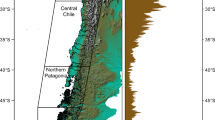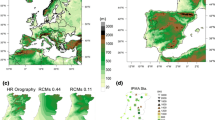Abstract
CORDEX-East Asia, a branch of the coordinated regional climate downscaling experiment (CORDEX) initiative, provides high-resolution climate simulations for the domain covering East Asia. This study analyzes temperature data from regional climate models (RCMs) participating in the CORDEX - East Asia region, accounting for the spatial dependence structure of the data. In particular, we assess similarities and dissimilarities of the outputs from two RCMs, HadGEM3-RA and RegCM4, over the region and over time. A Bayesian functional analysis of variance (ANOVA) approach is used to simultaneously model the temperature patterns from the two RCMs for the current and future climate. We exploit nonstationary spatial models to handle the spatial dependence structure of the temperature variable, which depends heavily on latitude and altitude. For a seasonal comparison, we examine changes in the winter temperature in addition to the summer temperature data. We find that the temperature increase projected by RegCM4 tends to be smaller than the projection of HadGEM3-RA for summers, and that the future warming projected by HadGEM3-RA tends to be weaker for winters. Also, the results show that there will be a warming of 1-3°C over the region in 45 years. More specifically, the warming pattern clearly depends on the latitude, with greater temperature increases in higher latitude areas, which implies that warming may be more severe in the northern part of the domain.
Similar content being viewed by others
References
Baek, H.-J., and Coauthors, 2013: Climate change in the 21st century simulated by hadgen2ao under representative concentration pathways. Asia-Pac. J. Atmos. Sci., 49, 603–618.
Christensen, J. H., and Coauthors, 2013: Climate phenomena and their relevance for future regional climate change. Climate Change 2013: The Physical Science Basis. Contribution of Working Group I to the Fifth Assessment Report of the Intergovernmental Panel on Climate Change, T. S. Stocker et al. Eds., Cambridge University Press, 1217–1308.
Davies, T., M. J. P. Cullen, A. J. Malcolm, M. H. Mawson, A. Staniforth, A. A. White, and N. Wood, 2005: A new dynamical core for the met office’s global and regional modeling of the atmosphere. Quart. J. Roy. Meteorol. Soc., 131, 1759–1782.
Furrer, R., M. Genton, and D. Nychka, 2006: Covariance tapering for interpolation of large spatial datasets. J. Comput. Graph. Stat., 15, 502–523.
Giorgi, F., C. Jones, and A. G. R., 2009: Addressing climate information needs at the regional level: the cordex framework. WMO Bull., 58, 175–183.
Giorgi, F., and Coauthors, 2012: Regcm4: model description and preliminary tests over multiple CORDEX domains. Clim. Res., 52, 7–29.
Greasby, T. A., and S. R. Sain, 2011: Multivariate spatial analysis of climate change projections. J. Agr. Biol. Environ. Stat., 16, 571–585.
Hawkins, E., and R. Sutton, 2009: The potential to narrow uncertainty in regional climate predictions. Bull. Amer. Meteor. Soc., 90, 1095–1107.
Kang, E., N. Cressie, and S. Sain, 2011: Combining outputs from the NARCCAP regional climate models using a Bayesian hierarchical model. Appl. Stat., 61, 291–313.
Kaufman, C., and S. R. Sain, 2010: Bayesian functional ANOVA modeling using Gaussian process prior distributions. Bayesian Anal., 5, 123–150.
Kaufman, C., M. Schervish, and D. Nychka, 2008: Covariance tapering for likelihood-based estimation in large spatial data sets. J. Am. Stat. Assoc., 103, 1545–1555.
Min, S.-K., E.-H. Park, and W.-T. Kwon, 2004: Future projections of East Asian climate change from multi-AOGCM ensembles of IPCC SRES scenario simulations. J. Meteor. Soc. Japan, 82, 1187–1211.
Min, S.-K., and Coauthors, 2015: Changes in weather and climate extremes over Korea and possible causes: A review. Asia-Pac. J. Atmos. Sci., 51, 103–121.
Moss, R. H., and Coauthors, 2010: The next generation of scenarios for climate change research and assessment. Nature, 463, 747–756.
Park, C., and Coauthors, 2016: Evaluation of multiple regional climate models for summer climate extremes over East Asia. Clim. Dynam., 46, 2469–2486.
Park, J.-H., S.-G. Oh, and M.-S. Suh, 2013: Impacts of boundary conditions on the precipitation simulation of regcm4 in the CORDEX East Asia domain. J. Geophys. Res., 118, 1652–1667.
Roberts, G., and S. Sahu, 1997: Updating schemes, correlation structure, blocking and parameterization for Gibbs sampler. J. Roy. Stat. Soc., 59, 291–317.
Sain, S. R., D. Nychka, and L. Mearns, 2011: Functional ANOVA and regional climate experiments: a statistical analysis of dynamic downscaling. Environmetrics, 22, 700–711.
Salazar, E., B. Sanò, A. O. Finley, D. Hammerling, I. Steinsland, X. Wang, and P. Delamater, 2011: Comparing and blending regional climate model predictions for the American southwest. J. Agr. Biol. Environ. Stat., 16, 586–605.
Sang, H., and J. Z. Huang, 2012: A full-scale approximation of covariance functions for large spatial data sets. J. Roy. Stat. Soc. Series B, 74, 111–132.
Sang, H., M. Jun, and J. Z. Huang, 2011: Covariance approximation for large multivariate spatial datasets with an application to multiple climate model errors. Ann. Appl. Stat., 5, 2519–2548.
Stein, M. L., 1999: Interpolation of Spatial Data: Some Theory for Kriging. Springer, 247 pp.
Stein, M. L., Z. Chi, and L. Welty, 2004: Approximating likelihoods for large spatial data sets. J. Roy. Stat. Soc. Series B, 275–296.
Suh, M.-S., and S.-G. Oh, 2012: Development of new ensemble methods based on the performance skills of regional climate models over South Korea. J. Climate, 25, 7067–7082.
Yasutomi, N., A. Hamada, and A. Yatagai, 2011: Development of a longterm daily gridded temperature dataset and its application to rain/snow discrimination of daily precipitation. Global Environ. Res., 15, 165–172.
Yatagai, A., K. Kaminguchi, O. Arakawa, A. Hamada, N. Yasutomi, and A. Kitoh, 2012: Aphrodite: Constructing a long-term daily gridded precipitation dataset for Asia based on a dense network of rain gauges. Bull. Am. Meteorol. Soc., 93, 1401–1415.
Author information
Authors and Affiliations
Corresponding author
Rights and permissions
About this article
Cite this article
Kim, Y., Jun, M., Min, SK. et al. Spatial analysis of future East Asian seasonal temperature using two regional climate model simulations. Asia-Pacific J Atmos Sci 52, 237–249 (2016). https://doi.org/10.1007/s13143-016-0022-z
Received:
Accepted:
Published:
Issue Date:
DOI: https://doi.org/10.1007/s13143-016-0022-z




